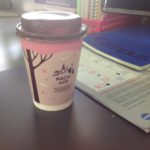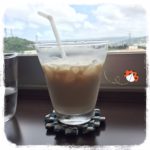In Okinawa, as summer approaches, the mornings are getting much warmer and the desire for an iced cafe latte grows stronger. Starbucks is too expensive, so where is the best deal for an iced coffee drink? Lawson conbini!
コンビニ conbini (or konbini) means convenience store. Lawson is a major chain of conbini throughout Japan. Conbini in Japan are amazing, and nothing like what you see stateside! But I will not get into all those details now. Right now, I will focus on Lawson’s machi cafe line.
Inside every Lawson, you can order several types of coffee drinks from the counter. My favorite during summer, of course, is an iced cafe latte アイスカフェラテ. I have tried iced cafe lattes all around the island, but I have found that the best priced (and consistently good tasting) one is at Lawson conbini, for a mere 150円. Comparing this to Starbucks which is usually more than 300円, I would say this is much more reasonable. FamilyMart, another large country-wide conbini chain, has iced cafe lattes for 180円, a little bit more than Lawson (but, also pretty darn good). In Okinawa, there is the occasional Tully’s (but they are not very common) and a scant few other chains with only one location about (Saint Marc ChocoCro, Doutor, Key Coffee), but they are so few and far between that I am rarely anywhere near them. There is the Climax Coffee chain, located on the other side of the island from me, similar to a Starbucks (similar price, too). There are several small independent shops which also have cafe lattes, but they tend to be fairly expensive, so while very good quality… simply not an everyday drink.
So when it comes down to affordability, taste and convenience for an iced cafe latte, Lawson wins.
Plus for you those of you who desire less caffeine… they just released a 97% caffeine cut series (basically, decaf) as of May 2017! This is great news for my husband, who can now enjoy an iced latte in the afternoon without worrying about caffeine.
Japanese coffee vocabulary: the best part is that it is almost always katakana!
コーヒー ko-hi coffee 珈琲 ko-hi- coffee (the kanji is based on the sounds not the meaning) ブレンド burendo blend アイス aisu iced フローズン furo-zun frozen ホット hotto hot カフェラテ kafe rate cafe latte カフェモカ kafe moka cafe mocha 抹茶ラテ maccha rate matcha (green tea) latte ロイヤルミルクティー roiyaru miruku ti- royal milk tea ココア kokoa cocoa アールグレイティー a-rugurei ti- Earl Grey tea 砂糖 satou sugar 砂糖なし** satou nashi: without sugar クリーム kuri-mu cream シロップ shiroppu sugar in syrup (liquid) form **なし nashi means "without"-- a very useful word!!
Okay, now this part may seem a little silly, but how do you order a machi cafe at Lawson if you don’t really know any Japanese? Let me help; just keep in mind there are often variations in speech patterns, so depending on your clerk, they may use different phrasing, as well as formal or casual speech.
First, before you approach the register, decide what you want from the menu (okay, maybe that is obvious). I get a latte, so let’s practice using that as an example.
ホットカフェラテ、おねがい(します)。hotto kafe rate, onegai (shimasu).
Hot cafe latte, please.
If I want it iced, I used アイス “aisu” instead of ホット “hotto.” Yes, seriously, we use Japanese English in this case.
The clerk will than ask what size if what you are ordering comes in 2 sizes. Sometimes I say the size when I order, but often times they will ask it again to confirm anyway. The shortest and most casual way they say this is as follows. Sometimes they will say it formally, but just listen for keywords.
サイズは? saizu wa? What size?
In which you reply:
Lサイズです。 eru saizu desu. L size.
or
Mサイズです。 emu saizu desu. M size.
At this point, they are probably ringing up your total. At some locations, the coffee pickup counter is to the side, so they will say something like:
となりのカウンターお待ちください tonari no kauntaa omachi kudasai. Please wait at the next counter.
Keep in mind there are many variations on this. The key word here is “machi” 待ち or “matte” 待って, meaning “waiting” or “to wait.” The other keyword is “kauntaa” which is “counter.”
Some places will ask how many sugars you will want either while they are ringing you up or while you are waiting for the machine to make you coffee. Listen for:
砂糖はいくつ(入れますか)? satou ha ikutsu (iremasuka)? How many sugars (do you put in)?
Keyword here is “satou” which is “sugar.”
Your response:
なしで。 nashi de. None.
一個。 ikko. One.
二個。niko. Two.
三個。sanko. Three.
Sometimes they do not ask about sugar and it is self-serve. In this case this will point to the little bin with sugars and stirrers and the like as they hand you your coffee (it will be obvious). They will instead say something like:
砂糖、どうぞ。 satou, douzo. Please help yourself to sugar.
When they hand you your coffee they often (but not always) say:
お待たせいたしました。omataseitashimashita. Thank you for waiting.
At this point when you receive your coffee you can respond with a casual “doumo,” or if you feel like “arigatou” or “doumo arigatou,” etc.
Again, keep in mind there are so many variations, and in order to not confuse you, I just put down some basics and keywords to listen for so your transaction can go smoothly! These are the “bite-sized” phrases to simply get you through the process. I like to remind people that in Okinawa, speaking informally is a bit more the norm; besides this, many people appreciate your effort in speaking even just a little Japanese as a foreigner, so worrying about formal/casual language is not nearly so important as many people make it out to be.

